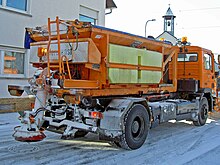Pre-wetted salt
Moistened salt (abbreviation FS ) is produced by moistening dry de-icing salt ("road salt") with salt solutions during winter service in the wet salt spreading process .
Basics
The thawing effect of salt is based on the lowering of the freezing point of a salt solution compared to salt-free water. Salt solutions have a lower freezing point than water; this decreases with increasing salt concentration until the eutectic point is reached. The formation of a solution, however, requires a film of moisture that must first form around the salt crystal that has been dryly applied to the road.
However, if the salt is applied directly as a saline solution, this moistening process is no longer necessary and the thawing process starts much faster. In addition, there are fewer losses during the application of the salt, since there are no dry salt crystals on the road that could be carried away by the wind, the wind vane of the gritting vehicle or other traffic. With such a salt solution, however, a large proportion of water would also be applied, which would reduce the salt concentration to the entire water supply on the street. Accordingly, more salt (in the form of brine) would have to be sprinkled in order to achieve the same thawing effect. This would cause a higher burden on the environment and higher costs.
Wet salt spreading method
The wet salt litter method combines the advantages of the two litter materials, dry salt and saline solution, and thus achieves a faster effect and lower pain loss while using lower amounts of salt and greater effectiveness. The dry de-icing salt is moistened with a salt solution ( brine ) before spreading . Sodium chloride (NaCl) - in concentrations of 22 or 26%, calcium chloride (CaCl 2 ) or magnesium chloride (MgCl 2 ) are used as brine .
The spreading with FS 30 (30 percent by mass (commonly: percent by weight) brine) has become generally accepted . A study showed that the FS-30 procedure was already regarded as the standard solution in municipal winter service in the winter service periods between 1984 and 1988. In addition, the variant with FS 5 is used - but much less often. Recently, FS 50 or even pure brine has also been used.
Wet salt spreading with FS 30
Dry salt is loaded into the grit containers of the winter service vehicles. This process requires the brine to be transported in separate brine tanks. These tanks are attached to the side of the grit containers. The spreaders must also have special humidification equipment.
De-icing salt and brine are separated during the entire transport. They are only mixed directly on the spreading disc in the course of spreading.
The mixing ratio is 70 percent by mass of de-icing salt and 30 percent by mass of brine, hence the name FS 30.
Wet salt spreading with FS 5
The dry de-icing salt is moistened when the gritting vehicle is loaded, so that all of the de-icing salt in the grit container of the winter service vehicle is moistened at the beginning of the gritting operation.
The moist mixture of de-icing salt and brine harbors the risk of caking, so that it can no longer be spread with the gritting vehicle. After the end of the spreading process, a complete emptying of the grit container is necessary in any case, which is usually carried out in the salt hall.
The mixing ratio is 95 percent by mass of de-icing salt and 5 percent by mass of moisture, hence FS 5.
user
The regional road service in Tyrol began experimentally with pure brine spreading in winter 2018/2019.
Individual evidence
- ↑ Solutions - Deutscher Straßen-Dienst GmbH , dsd-winterdienst.de, accessed August 5, 2020. Drawing of a spreading plate with brine and salt added. - 100% subsidiary of K + S Minerals and Agriculture GmbH, the largest European salt producer. According to the data sheets, the beginning of crystal separation is indicated at <–19 ° C (NaCl brine 22 (21–23%)) or <0 ° C (NaCl brine 26%).
- ↑ Walter Durth; Horst Hanke: Wet salt distribution in the municipal road service. Der Städtetag, 1991, p. 581 ff.
- ↑ ASTRA : Organic brine additives - assessment of the relevance of water bodies when using organic brine additives based on agricultural by-products , December 2014.
- ↑ State of Tyrol: Winter service in Tyrol starts experiment with pure brine spreading November 28, 2018, accessed August 5, 2020.
literature
- Leaflet for winter road maintenance. Edition 2010 published by the Research Association for Roads and Transport, Infrastructure Management Working Group. FGSV-Verlag, Cologne 2010, ISBN 978-3-941790-52-0 , pp. 15-19.
- Manfred Wichmann: Street cleaning and winter service in municipal practice. Legal basis - organization - tasks. (8th edition), Erich Schmidt Verlag, Berlin 2018, ISBN 978-3-503-17643-4 , Rn. 294.
- Horst Badelt: Optimizing the moistening of de-icing salts. (Reports of the Federal Highway Research Institute, Traffic Technology Issue 156; PDF; 1.2 MB), ed. from the Federal Highway Research Institute. Wirtschaftsverlag NW, Verlag für Neue Wissenschaft, Bremerhaven 2007, ISBN 978-3-86509-687-6 .
- Walter Durth; Horst Hanke: Manual Road Winter Service. Kirschbaum Verlag, Bonn 2004, ISBN 3-7812-1616-0 , pp. 143-147.
- Franz Götzfried: Types of litter. In: Helmuth Hüttl (ed.): Municipal winter service and urban cleaning: Valuable information and lectures. Books on Demand, Norderstedt 2012, ISBN 978-3-8448-1946-5 , pp. 179-215 (209 f.)
- TU Wien: Research report on the optimization of wet salt spreading
- Horst Badelt, Franz Götzfried: Scatter materials. In: Günter Hausmann (Ed.): KommunalHandbuch Winterdienst. Beckmann Verlag, Lehrte 2013, ISBN 978-3-9813013-3-5 , pp. 31-52.

